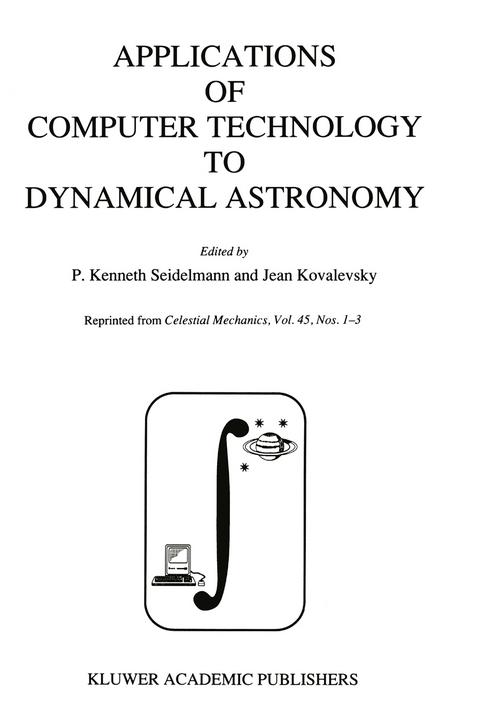
Applications of Computer Technology to Dynamical Astronomy
Springer (Verlag)
978-94-010-6932-8 (ISBN)
decision and investigative process of the scientist, they can also wri te the paragra}ils of scientific resul ts. Once a canputer research activity progresses from intuitive guesses to a systematic study, the canputer program can free the scientist to pursue new original ideas. '!his concept is illustrated in the ptper by Hut. Sussnan says "Knowledge" is knowing what not to canpute. His main message is that we must change from trying to maximize the efficiency of the canputer to maximizing the effectiveness of the scientist. The canputer is relatively cheap, it is the trained scientist who is most valuable. In the second keynote address, R. L. Duncombe (University of Texas) described the "Early Applications of Canputer Technology to Dynamical Astronany. " His talk traced the worldwide introduction of punched card equipnent and their applications through the use of the first electronic canputers. Sussman and Duncombe, therefore, provided a forecast and review of the use of computers in dynamical astronany. This proceedings is intended to provide a consolidated general view of the ptst, present, and future of the Applications of Canputer Technology to Dynamical Astronany.
Of necessity this requires that the ptpers be rela ti vely short and provide references to the more canplete discussions. Thanks to the representa tion from so many different countries the proceedings give a picture of the activities worldwide. The Scientific Organizing Comnittee included K. B. IIlatnagar, V. A. Brtmberg, G. Contopoulos, A. Depri t , J. Henrard, J. Kovalevsky, Y.
1/Applications of Computers to Solving Problems.- Early Applications of Computer Technology to Dynamical Astronomy.- Applications of Computers to Celestial Mechanics.- Applications to Stellar and Galactic Dynamics.- Application of Computer in Qualitative Studies of Celestial Mechanics.- Leading Spiral Arms, Retrograde Galaxy Encounters and Massive Halos.- On Construction of Analytic Solutions to the Three Body Problem by Use of Computer Experiments.- The Use of Computer Algorithms in the Construction of a Theory of the Long-Period Perturbations of Saturn’s Satellite Hyperion.- Some Numerical Aspects in a Search for I=1 Periodic Orbits for Hecuba Asteroids.- SHORDE I Program System and Applications.- A Semi-numerical Expansion of the Averaged Disturbing Function for Some Very-high-eccentricity Orbits.- Symbolic Algebra Software for Planetary Theories.- Tests of the Extrapolation Method for the Numerical Integration of the Keplerian Motion.- Application of a Massively Parallel Computer to the N-body Problem.- Hydrodynamical Models of Elliptical Galaxies.- A Multifluid Code for Problems of Elliptical Galaxy Formation and Evolution.- 3D Hydrodynamics and Radiative Transfer.- First-order and Second-order 3-D Hydrodynamics: A Comparison.- Chaotic Dynamics and Monte Carlo Modelling.- Software Tools for Nonlinear Dynamics.- Computer Algebra, Lie Transforms and the Nonlinear Stability of L4.- Solution of an Infinite Number of Inequations Depending on a Continuous Parameter and Application to the Solution of Equations in Dynamical Astronomy.- 2/Matching Problems with Technology.- Planet Crossing Asteroids and Parallel Computing: Project Spaceguard.- Implementation of an N-body Code in a HP1000 Computer.- Computer Applications to Lunar and Artificial Satellite Laser Ranging.-The Use of Image Processors for Acquisition and Reduction of Astrometric Data in Real Time.- Modeling of Asymmetric Light Curves of Eclipsing Binaries on the Cyber 205 Supercomputer.- Galaxies in the Connection Machine.- 3/New Methods of Mathematical Programming.- Specialized Celestial Mechanics Systems for Symbolic Manipulation.- On a Restricted (2n+3)-Body Problem.- The Simplex Method for Nonlinear Mass Determinations.- An Optimum Method for Calculating Restricted Three-Body Orbits.- The Constrained Normal Form Algorithm.- 4/Matching Computer Language to the Problem.- Simplify or Perish.- The Stability of the Lagrangian Point L4.- Computer Implementation of a New Approach to the Ideal Resonance Problem.- A Laboratory for Gravitational Scattering Experiments.- Problem Oriented Language for Ephemeris Astronomy and its Realisation in the System ERA.- 5/Use of Numerical Versus Algebraic Computation.- Numerical Integration Methods in Dynamical Astronomy.- A Survey of Poisson Series Processors.- A FORTRAN-based Poisson Series Processor and its Applications in Celestial Mechanics.- PARSEC: An Interactive Poisson Series Processor for Personal Computing Systems.- The Problem of the Eulerian Oscillations: A Weakness of Numerical Versus Analytical Methods.- A Semi-Analytical Method to Study Perturbed Rotational Motion.- Computational Studies of Cloudy Gaseous Galactic Disks.- 6/Representation and Transmission of Results.- Synthetic Secular Theories of the Planetary Orbits: Regular and Chaotic Behaviour.- Numerical Representation of Planetary Ephemerides.- Compressed Planetary and Lunar Ephemerides.- An Analytical Representation of Ephemeris Data.- Numerical Simulations of Narrow Planetary Rings: An Animation.- Electronic Almanacs Mating the Message and the Medium.- List of Participants.- Errata.
| Zusatzinfo | X, 341 p. |
|---|---|
| Verlagsort | Dordrecht |
| Sprache | englisch |
| Maße | 160 x 240 mm |
| Themenwelt | Mathematik / Informatik ► Informatik ► Theorie / Studium |
| Mathematik / Informatik ► Mathematik ► Angewandte Mathematik | |
| Naturwissenschaften ► Physik / Astronomie ► Astronomie / Astrophysik | |
| ISBN-10 | 94-010-6932-8 / 9401069328 |
| ISBN-13 | 978-94-010-6932-8 / 9789401069328 |
| Zustand | Neuware |
| Haben Sie eine Frage zum Produkt? |
aus dem Bereich


